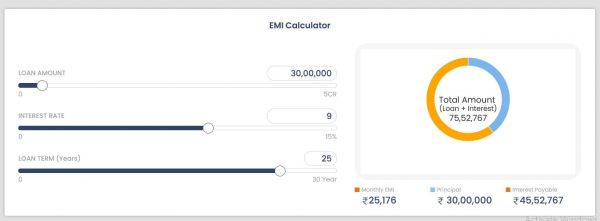We use EMI to pay off both principal and interest on a loan. First, EMI has the lowest principal and highest interest. With each EMI, the interest decreases but the principal increases.
If a borrower prepays a running loan, subsequent EMIs, the loan's original tenure decreases, or both.
When a borrower misses an EMI during the loan's duration, subsequent EMIs rise, the loan's tenure increases, or a mix of both, along with any financial penalty.
Similarly, if the Interest rate decreases throughout the loan's tenure, the EMIs or loan tenure decreases, or both. The opposite occurs when Interest rates rise.
This article gives an overview on Loan EMI Calculator ICICI.
What is an EMI?
An equated monthly installment is a set monthly payment a borrower pays to a creditor on a specified day. Monthly EMIs include principles and interests.
EMIs aren't flexible payment arrangements where the borrower pays more. EMI borrowers generally make one monthly payment.
An EMI helps borrowers arrange their finances since they know how much to pay monthly. Loan Interest provides a consistent and predictable income to lenders.
How to Use an EMI Calculator?

Using the following formula, an EMI calculator determines the monthly repayment amount.
EMI= [p*r * (1+r) ^n]/[(1+r) ^n-1]
p, r, and n are variables.
P= principal amount. The loan amount depends on the purpose and need. Higher loan amounts mean higher EMIs.
r is 'Interest Rate'. It is the loan Interest rate, and Interest rates vary by loan type and lender (bank). The Interest rate affects your EMI, so compare rates across banks before taking a loan.
n= number of years and it is tenure. As the repayment is monthly, we calculate the tenure in months, not years.
Learn how the EMI calculator works by following this example. You've borrowed Rs 1 lakh for two years at a 10% Interest rate.
E= [p*r * (1+r) ^n]/[(1+r) ^n-1]
E= EMI, r = 10/100/12, p= Rs 1,00,000, n = 24 months.
E = [1,00,000 * 0.00833 * (1+0.00833) ^24]/ (1+0.0083) ^24 – 1]
E= Rs 4,615.
Advantages of using EMI Calculator
- Use the calculator anywhere
- You can use a loan EMI calculator anywhere. You don't have to go to the bank and figure out complex mathematical formulas that could make you crazy. It is much better.
Less time-consuming
Manual calculations require a long time. Every step of the way would put your patience to the test. Using an EMI calculator for a home loan is better because it works quickly and smoothly.
Every time you use a home loan EMI calculator, you get an accurate result.
Finding the best offer on a bank's loan
Compare loan offers from different banks when applying for a loan. Your EMI loan calculator will come in handy in this situation. Find the loan's total cost and EMIs.
This way, you can select the best loan option for your needs. Loan interest rates vary by lender. A 0.04 percent difference in loan rates may have a big impact.
Use loan-specific EMI calculator
Loan-specific EMI calculator simplifies your job. You can use a different calculator for education, home, or car loan.
Even if loan parameters are similar, you may need loan-specific EMI calculators for some cases. One way to determine if an EMI calculator is appropriate is to use it only for one specific loan.
Easy calculation

Calculating your EMI is critical before completing any loan processes.
Because everything hinges on calculations, if you're a loan applicant, enter the loan amount,
loan period, processing fee, and interest rate.
The home loan calculator calculates EMI. The loan amount calculator shows how much you can borrow.
Effect of loan prepayment on your Installment payments
Some banks offer prepayment to help borrowers repay their loans before the actual repayment tenure. You can make the prepayment in instalments or in full.
How loan prepayment works depends on whether you choose part- or full-prepayment. With part-prepayment, you repay a lump sum from the total loan amount.
After a year, most banks let you prepay the outstanding amount. You will save a lot of interest if you repay the loan in full. Here's an example of how you'll benefit:
Let's say you took a five-year loan for Rs. 3 lakhs at a 15 % annual interest rate. If the processing fee is 2%, your equated monthly installment (EMI) will be Rs. 7,137 after the estimations.
You'll pay Rs. 35,529 in interest after a year. You will save Rs57,049 in Interest if you now prepay the outstanding balance of Rs2,64,160.
Some banks charge for loan foreclosure. Fees range from 2% to 5% of the outstanding balance.
Calculate costs and prepayment savings using an online EMI calculator.
All you have to do is fill out the loan details, including the loan amount, the tenure, the interest rate, the processing fee (if applicable), and the method of prepayment or foreclosure.
The RBI instructed banks not to impose pre-closure charges. However, this only applies to lenders with floating interest rates. So If you choose full repayment, know the possible foreclosure charges.
Following are the things to consider before prepaying a loan.
- Lock-in period: Most banks have a one-to-three-year lock-in period during which you can't prepay the loan. RBI rules say floating-rate loans have no lock-ins.
- Prepayment penalty: Bank may charge a penalty for early loan repayments. Check to see if the penalty is greater than the interest savings.
- Rate of Interest on a loan: Most banks use the reducing balance method to figure out the interest on a loan.
As a result, the interest component is higher at the beginning and lowers as the tenure length decreases. A loan prepayment calculator can tell you how much interest you'll save by prepaying.
Factors that can impact your due amount
- Credit score
High credit scores are essential for EMIs. If your credit score is over 750 you can get a low-interest loan. - Existing debt
Existing debt isn't a problem, but too many loans, especially unsecured ones, might be. Lenders will perceive you as credit-hungry and will not lend quickly.
Late payments might also impact your credit. Low credit scores make lenders hesitant to lend and increase interest rates. - Type of interest rate
Floating or fixed interest rates impact EMI payments. If you choose a fixed rate, you'll have the same rate throughout the repayment term.
RBI determines floating interest rates, which might change during repayment. Your EMI will increase if interest rates increase. - Your age and income
The older you are, particularly after retirement, the higher the lender's default risk due to income uncertainty.
It is why older individuals, especially retirees, have trouble getting loans. If you have a consistent income, you may get loans at lower interest rates, lowering your EMI. - Change in the interest rate or loan tenure
Although reducing your repayment period or interest rate is rare, this might affect your EMI payment.
FAQs
1. Are the calculators for home, car, and personal loans the same?
Mostly, they're the same because they depend on the same basic information like the amount of money borrowed, prepayments, the length of the loan period, the interest rate, and the processing fee.
2. How to calculate loan EMIs?
When calculating the monthly payment for your loan, the formula is E= [p*r * (1+r) ^n]/[(1+r) ^n-1]
where r is the monthly interest rate, P is the Principal Loan Amount, E is the EMI, and n is the loan duration in months.
3. What If I fail to pay my EMIs?
Lenders will take action against you if you miss three payments in a row.
As a result, the lender will send you a default notice with a time limit by which you must pay back the unpaid debt or risk losing possession of the collateral you provided.
4. What does an EMI consist of?
The interest and principal components of each EMI depend on the outstanding loan balance, interest rate, and term.
The reducing-balance EMI calculates interest depending on the loan balance, resulting in reduced interest payments.
5. Is the Equated Monthly Instalment amount shown by the calculator the same as that which the bank will ask me to pay?
When it comes to the EMI, assuming the bank approves the amount and duration, the precise installment you'll have to pay may differ slightly from what you used to calculate the due amount due to variables like processing fees and interest rates.
